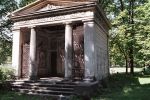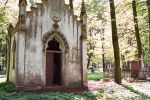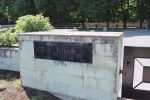
At first glance, the Great Cemetery, Lielie kapi, appears a bucolic setting, like any park
At first glance, the Great Cemetery, Lielie kapi, appears a bucolic setting, like any park
At first glance, the Great Cemetery, Lielie kapi, appears a bucolic setting, like any park

More than one surviving mausoleum is adorned with a makeshift door
More than one surviving mausoleum is adorned with a makeshift door
More than one surviving mausoleum is adorned with a makeshift door

Albrecht von Oprotkovitsch, April 1757 - February 21, 1821, Field Hospital Chief Surgeon, and if we understand correctly, knighted by the tsar
Albrecht von Oprotkovitsch, April 1757 - February 21, 1821, Field Hospital Chief Surgeon, and if we understand correctly, knighted by the tsar
Albrecht von Oprotkovitsch, April 1757 - February 21, 1821, Field Hospital Chief Surgeon, and if we understand correctly, knighted by the tsar

Here rests Carl Reinhold Baron Schilling, died on 19 September 1855, if you look closely, this is the mausoleum at the center of our initial bucolic view
Here rests Carl Reinhold Baron Schilling, died on 19 September 1855, if you look closely, this is the mausoleum at the center of our initial bucolic view
Here rests Carl Reinhold Baron Schilling, died on 19 September 1855, if you look closely, this is the mausoleum at the center of our initial bucolic view

An echo of Rīga's aristocratic past
An echo of Rīga's aristocratic past
An echo of Rīga's aristocratic past

In everlasting peace here sleeps Nikolajs Mārtiņš Senbergs, June 3, 1916 - June 12, 1943, his grave still tended to
In everlasting peace here sleeps Nikolajs Mārtiņš Senbergs, June 3, 1916 - June 12, 1943, his grave still tended to
In everlasting peace here sleeps Nikolajs Mārtiņš Senbergs, June 3, 1916 - June 12, 1943, his grave still tended to

Most mausoleums, like this of Nicolai Pychlau, lie open, looted, and vandalized
Most mausoleums, like this of Nicolai Pychlau, lie open, looted, and vandalized
Most mausoleums, like this of Nicolai Pychlau, lie open, looted, and vandalized

One can see Nicolai Pychlau's mausoleum must have been among the grandest. Nicolai was the middle son of a textile factory owner. Since 1880, he and his family supported the Rīga society and institute for the blind. Family members continued to support, and lead, the institute until just before the First World War.
One can see Nicolai Pychlau's mausoleum must have been among the grandest. Nicolai was the middle son of a textile factory owner. Since 1880, he and his family supported the Rīga society and institute for the blind. Family members continued to support, and lead, the institute until just before the First World War.
One can see Nicolai Pychlau's mausoleum must have been among the grandest. Nicolai was the middle son of a textile factory owner. Since 1880, he and his family supported the Rīga society and institute for the blind. Family members continued to support, and lead, the institute until just before the First World War.

A mausoleum sunken into anonymity
A mausoleum sunken into anonymity
A mausoleum sunken into anonymity

The Vanags family plot. Aleksandrs Vanags was an accomplished architect practicing in the Art Nouveau (Jugendstil) style, his handiwork still stands in Rīga. Vanags was killed by the Bolsheviks in 1919
The Vanags family plot. Aleksandrs Vanags was an accomplished architect practicing in the Art Nouveau (Jugendstil) style, his handiwork still stands in Rīga. Vanags was killed by the Bolsheviks in 1919
The Vanags family plot. Aleksandrs Vanags was an accomplished architect practicing in the Art Nouveau (Jugendstil) style, his handiwork still stands in Rīga. Vanags was killed by the Bolsheviks in 1919

Artist Kārlis Jurjāns, 1884-1951
Artist Kārlis Jurjāns, 1884-1951
Artist Kārlis Jurjāns, 1884-1951

At a far corner of Lielie kapi, Peters ran across a curious little cemetery
At a far corner of Lielie kapi, Peters ran across a curious little cemetery
At a far corner of Lielie kapi, Peters ran across a curious little cemetery

A closer look reveals German names, deceased during WWII
A closer look reveals German names, deceased during WWII
A closer look reveals German names, deceased during WWII

Exiting, Peters found the sign at the entrance, the Rīga German Soldiers' Cemetery, 1939-1945
Exiting, Peters found the sign at the entrance, the Rīga German Soldiers' Cemetery, 1939-1945
Exiting, Peters found the sign at the entrance, the Rīga German Soldiers' Cemetery, 1939-1945

The German Soldiers' Cemetery entrance, the cemetery is now gone, the remains relocated to an existing German Soldiers' Cemetery in Beberbeķi. That cemetery was established in 2007, anticipated to house some 12,000 remains of soldiers formerly buried in forests, marshes, roadside graves, and other places not appropriate for a final resting place
The German Soldiers' Cemetery entrance, the cemetery is now gone, the remains relocated to an existing German Soldiers' Cemetery in Beberbeķi. That cemetery was established in 2007, anticipated to house some 12,000 remains of soldiers formerly buried in forests, marshes, roadside graves, and other places not appropriate for a final resting place
The German Soldiers' Cemetery entrance, the cemetery is now gone, the remains relocated to an existing German Soldiers' Cemetery in Beberbeķi. That cemetery was established in 2007, anticipated to house some 12,000 remains of soldiers formerly buried in forests, marshes, roadside graves, and other places not appropriate for a final resting place

We close our gallery having strolled through another day, passing by the gravesite of poet Andrejs Pumpurs, author of the Latvian epic poem Lāčplēsis, the Bear Slayer
We close our gallery having strolled through another day, passing by the gravesite of poet Andrejs Pumpurs, author of the Latvian epic poem Lāčplēsis, the Bear Slayer
We close our gallery having strolled through another day, passing by the gravesite of poet Andrejs Pumpurs, author of the Latvian epic poem Lāčplēsis, the Bear Slayer


 Gallery
Gallery














